HI6028 Taxation Theory, Practice, and Law: Assessment Solution
VerifiedAdded on 2023/01/09
|6
|1915
|48
Homework Assignment
AI Summary
This document contains a comprehensive solution to the HI6028 Taxation Theory, Practice, and Law assignment for Trimester 1, 2020. The assignment assesses the student's understanding of Australian taxation principles through five questions. Question 1 analyzes whether various scenarios, including barter transactions and the exchange of services for goods, give rise to taxable income, referencing relevant legislation and case law. Question 2 explores the assessability or exemption of income from scholarships and part-time army reserve remuneration. Question 3 involves calculating deductible expenses for a teacher working from home, considering expenses like rent, utilities, and phone bills. Question 4 focuses on calculating the taxable value for Fringe Benefits Tax (FBT) purposes, concerning payments made by an employer. Finally, Question 5 examines partnership taxation, addressing the commissioner's authority to disallow salary claims, the available courses of action for partners, the tax implications for a partner's wife, and the basis for future salary payments. The solution provides detailed explanations and calculations, referencing relevant tax laws and regulations.
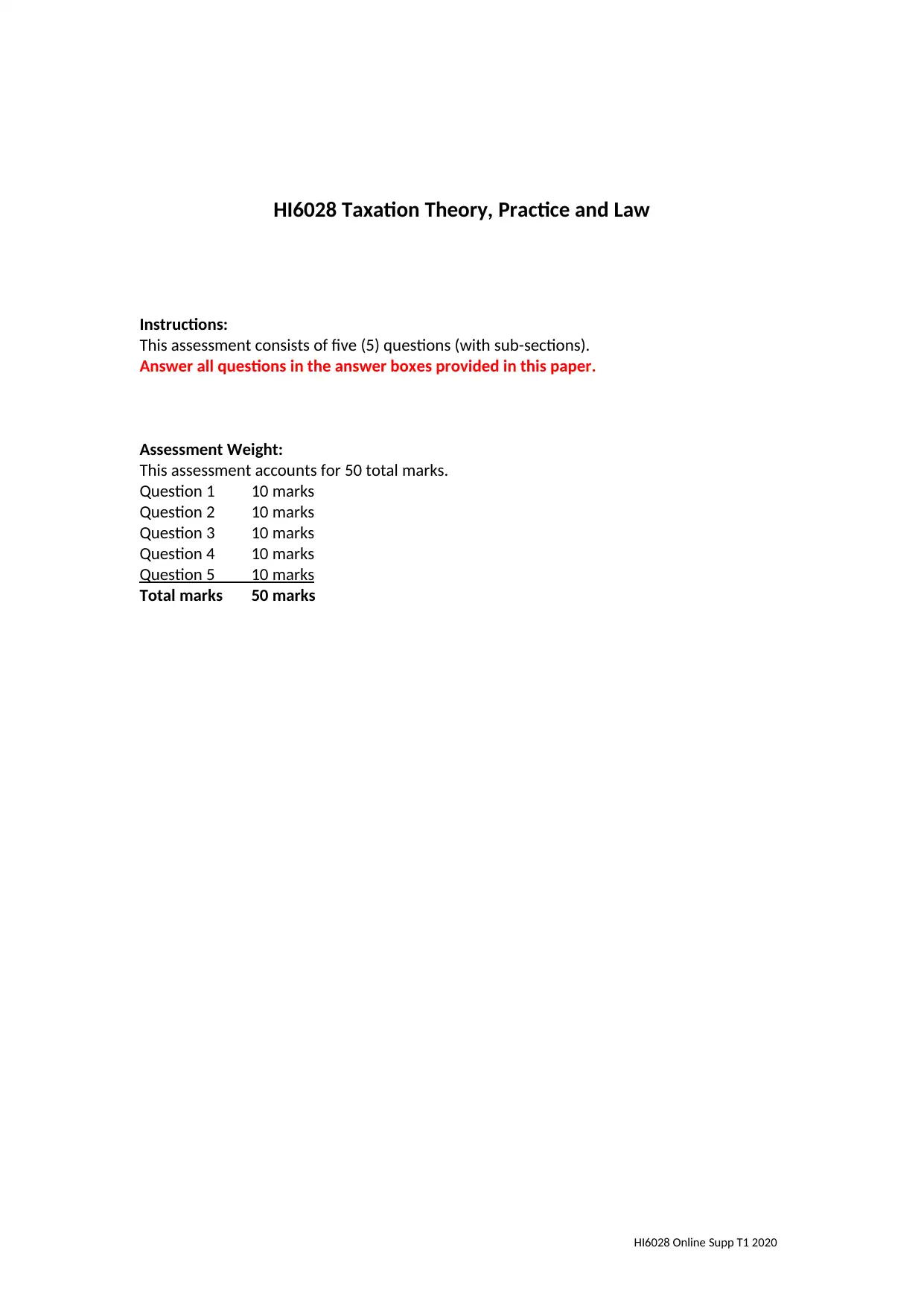
HI6028 Taxation Theory, Practice and Law
Instructions:
This assessment consists of five (5) questions (with sub-sections).
Answer all questions in the answer boxes provided in this paper.
Assessment Weight:
This assessment accounts for 50 total marks.
Question 1 10 marks
Question 2 10 marks
Question 3 10 marks
Question 4 10 marks
Question 5 10 marks
Total marks 50 marks
HI6028 Online Supp T1 2020
Instructions:
This assessment consists of five (5) questions (with sub-sections).
Answer all questions in the answer boxes provided in this paper.
Assessment Weight:
This assessment accounts for 50 total marks.
Question 1 10 marks
Question 2 10 marks
Question 3 10 marks
Question 4 10 marks
Question 5 10 marks
Total marks 50 marks
HI6028 Online Supp T1 2020
Paraphrase This Document
Need a fresh take? Get an instant paraphrase of this document with our AI Paraphraser
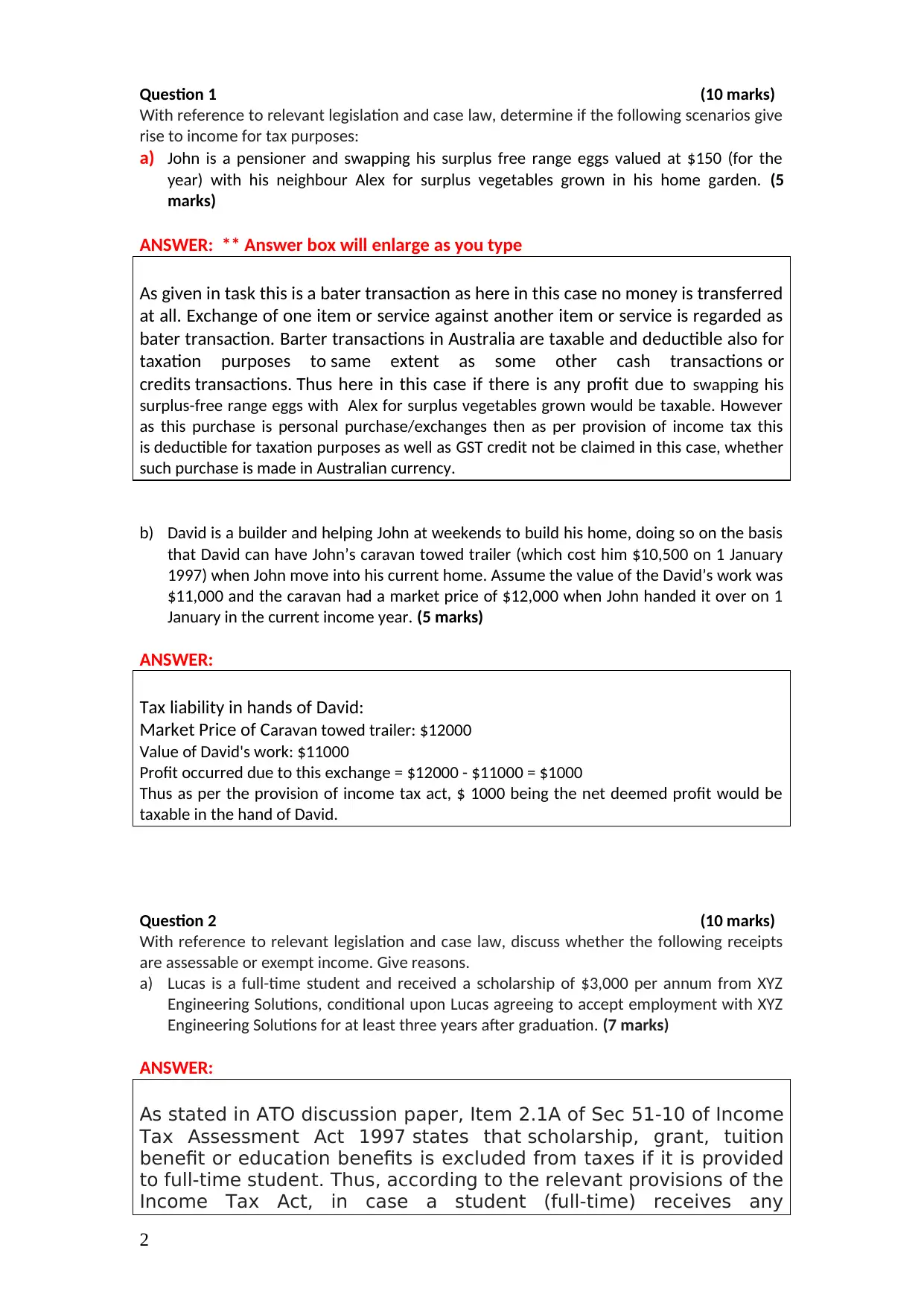
Question 1 (10 marks)
With reference to relevant legislation and case law, determine if the following scenarios give
rise to income for tax purposes:
a) John is a pensioner and swapping his surplus free range eggs valued at $150 (for the
year) with his neighbour Alex for surplus vegetables grown in his home garden. (5
marks)
ANSWER: ** Answer box will enlarge as you type
As given in task this is a bater transaction as here in this case no money is transferred
at all. Exchange of one item or service against another item or service is regarded as
bater transaction. Barter transactions in Australia are taxable and deductible also for
taxation purposes to same extent as some other cash transactions or
credits transactions. Thus here in this case if there is any profit due to swapping his
surplus-free range eggs with Alex for surplus vegetables grown would be taxable. However
as this purchase is personal purchase/exchanges then as per provision of income tax this
is deductible for taxation purposes as well as GST credit not be claimed in this case, whether
such purchase is made in Australian currency.
b) David is a builder and helping John at weekends to build his home, doing so on the basis
that David can have John’s caravan towed trailer (which cost him $10,500 on 1 January
1997) when John move into his current home. Assume the value of the David’s work was
$11,000 and the caravan had a market price of $12,000 when John handed it over on 1
January in the current income year. (5 marks)
ANSWER:
Tax liability in hands of David:
Market Price of Caravan towed trailer: $12000
Value of David's work: $11000
Profit occurred due to this exchange = $12000 - $11000 = $1000
Thus as per the provision of income tax act, $ 1000 being the net deemed profit would be
taxable in the hand of David.
Question 2 (10 marks)
With reference to relevant legislation and case law, discuss whether the following receipts
are assessable or exempt income. Give reasons.
a) Lucas is a full-time student and received a scholarship of $3,000 per annum from XYZ
Engineering Solutions, conditional upon Lucas agreeing to accept employment with XYZ
Engineering Solutions for at least three years after graduation. (7 marks)
ANSWER:
As stated in ATO discussion paper, Item 2.1A of Sec 51-10 of Income
Tax Assessment Act 1997 states that scholarship, grant, tuition
benefit or education benefits is excluded from taxes if it is provided
to full-time student. Thus, according to the relevant provisions of the
Income Tax Act, in case a student (full-time) receives any
2
With reference to relevant legislation and case law, determine if the following scenarios give
rise to income for tax purposes:
a) John is a pensioner and swapping his surplus free range eggs valued at $150 (for the
year) with his neighbour Alex for surplus vegetables grown in his home garden. (5
marks)
ANSWER: ** Answer box will enlarge as you type
As given in task this is a bater transaction as here in this case no money is transferred
at all. Exchange of one item or service against another item or service is regarded as
bater transaction. Barter transactions in Australia are taxable and deductible also for
taxation purposes to same extent as some other cash transactions or
credits transactions. Thus here in this case if there is any profit due to swapping his
surplus-free range eggs with Alex for surplus vegetables grown would be taxable. However
as this purchase is personal purchase/exchanges then as per provision of income tax this
is deductible for taxation purposes as well as GST credit not be claimed in this case, whether
such purchase is made in Australian currency.
b) David is a builder and helping John at weekends to build his home, doing so on the basis
that David can have John’s caravan towed trailer (which cost him $10,500 on 1 January
1997) when John move into his current home. Assume the value of the David’s work was
$11,000 and the caravan had a market price of $12,000 when John handed it over on 1
January in the current income year. (5 marks)
ANSWER:
Tax liability in hands of David:
Market Price of Caravan towed trailer: $12000
Value of David's work: $11000
Profit occurred due to this exchange = $12000 - $11000 = $1000
Thus as per the provision of income tax act, $ 1000 being the net deemed profit would be
taxable in the hand of David.
Question 2 (10 marks)
With reference to relevant legislation and case law, discuss whether the following receipts
are assessable or exempt income. Give reasons.
a) Lucas is a full-time student and received a scholarship of $3,000 per annum from XYZ
Engineering Solutions, conditional upon Lucas agreeing to accept employment with XYZ
Engineering Solutions for at least three years after graduation. (7 marks)
ANSWER:
As stated in ATO discussion paper, Item 2.1A of Sec 51-10 of Income
Tax Assessment Act 1997 states that scholarship, grant, tuition
benefit or education benefits is excluded from taxes if it is provided
to full-time student. Thus, according to the relevant provisions of the
Income Tax Act, in case a student (full-time) receives any
2
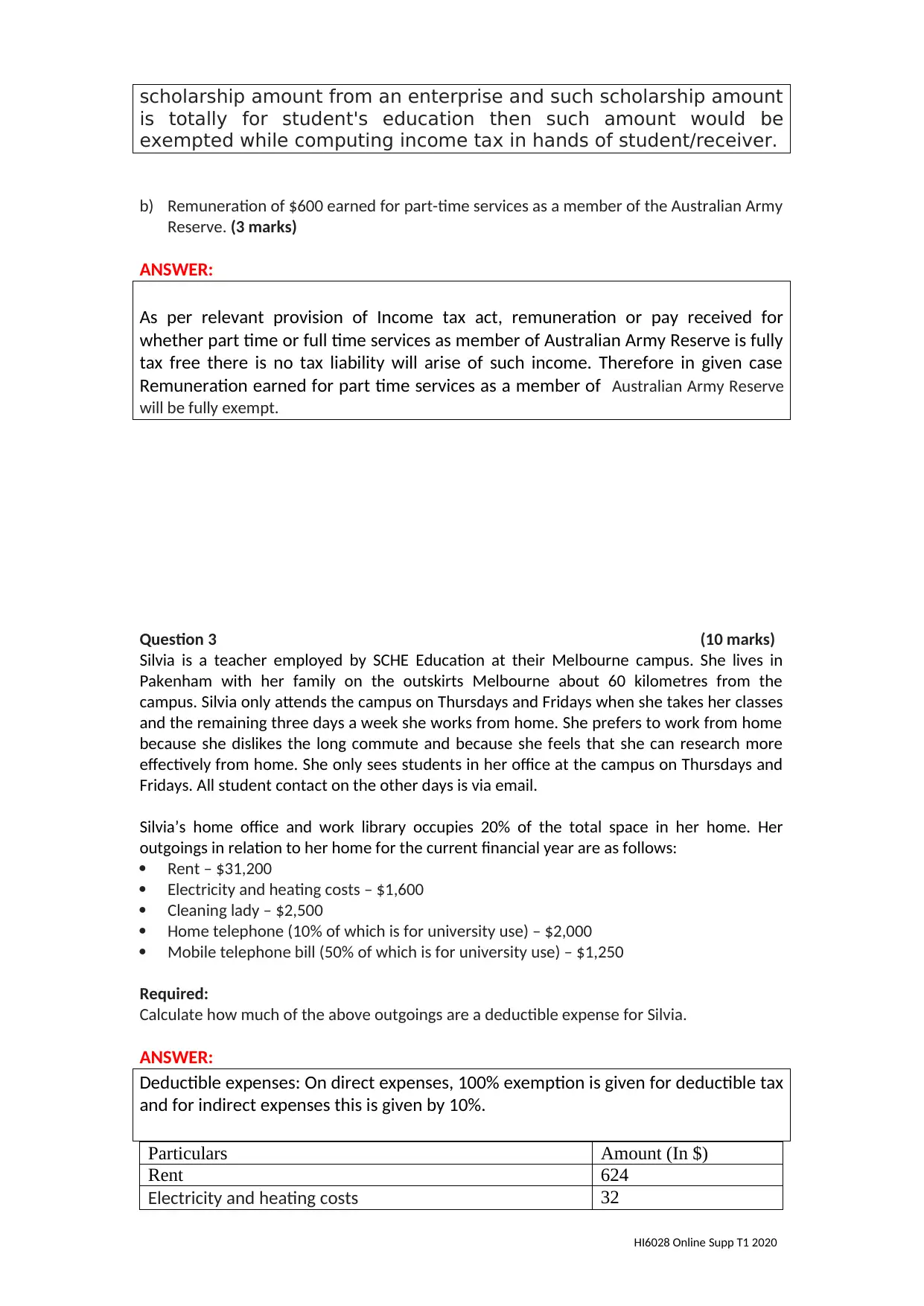
scholarship amount from an enterprise and such scholarship amount
is totally for student's education then such amount would be
exempted while computing income tax in hands of student/receiver.
b) Remuneration of $600 earned for part-time services as a member of the Australian Army
Reserve. (3 marks)
ANSWER:
As per relevant provision of Income tax act, remuneration or pay received for
whether part time or full time services as member of Australian Army Reserve is fully
tax free there is no tax liability will arise of such income. Therefore in given case
Remuneration earned for part time services as a member of Australian Army Reserve
will be fully exempt.
Question 3 (10 marks)
Silvia is a teacher employed by SCHE Education at their Melbourne campus. She lives in
Pakenham with her family on the outskirts Melbourne about 60 kilometres from the
campus. Silvia only attends the campus on Thursdays and Fridays when she takes her classes
and the remaining three days a week she works from home. She prefers to work from home
because she dislikes the long commute and because she feels that she can research more
effectively from home. She only sees students in her office at the campus on Thursdays and
Fridays. All student contact on the other days is via email.
Silvia’s home office and work library occupies 20% of the total space in her home. Her
outgoings in relation to her home for the current financial year are as follows:
Rent – $31,200
Electricity and heating costs – $1,600
Cleaning lady – $2,500
Home telephone (10% of which is for university use) – $2,000
Mobile telephone bill (50% of which is for university use) – $1,250
Required:
Calculate how much of the above outgoings are a deductible expense for Silvia.
ANSWER:
Deductible expenses: On direct expenses, 100% exemption is given for deductible tax
and for indirect expenses this is given by 10%.
Particulars Amount (In $)
Rent 624
Electricity and heating costs 32
HI6028 Online Supp T1 2020
is totally for student's education then such amount would be
exempted while computing income tax in hands of student/receiver.
b) Remuneration of $600 earned for part-time services as a member of the Australian Army
Reserve. (3 marks)
ANSWER:
As per relevant provision of Income tax act, remuneration or pay received for
whether part time or full time services as member of Australian Army Reserve is fully
tax free there is no tax liability will arise of such income. Therefore in given case
Remuneration earned for part time services as a member of Australian Army Reserve
will be fully exempt.
Question 3 (10 marks)
Silvia is a teacher employed by SCHE Education at their Melbourne campus. She lives in
Pakenham with her family on the outskirts Melbourne about 60 kilometres from the
campus. Silvia only attends the campus on Thursdays and Fridays when she takes her classes
and the remaining three days a week she works from home. She prefers to work from home
because she dislikes the long commute and because she feels that she can research more
effectively from home. She only sees students in her office at the campus on Thursdays and
Fridays. All student contact on the other days is via email.
Silvia’s home office and work library occupies 20% of the total space in her home. Her
outgoings in relation to her home for the current financial year are as follows:
Rent – $31,200
Electricity and heating costs – $1,600
Cleaning lady – $2,500
Home telephone (10% of which is for university use) – $2,000
Mobile telephone bill (50% of which is for university use) – $1,250
Required:
Calculate how much of the above outgoings are a deductible expense for Silvia.
ANSWER:
Deductible expenses: On direct expenses, 100% exemption is given for deductible tax
and for indirect expenses this is given by 10%.
Particulars Amount (In $)
Rent 624
Electricity and heating costs 32
HI6028 Online Supp T1 2020
⊘ This is a preview!⊘
Do you want full access?
Subscribe today to unlock all pages.

Trusted by 1+ million students worldwide
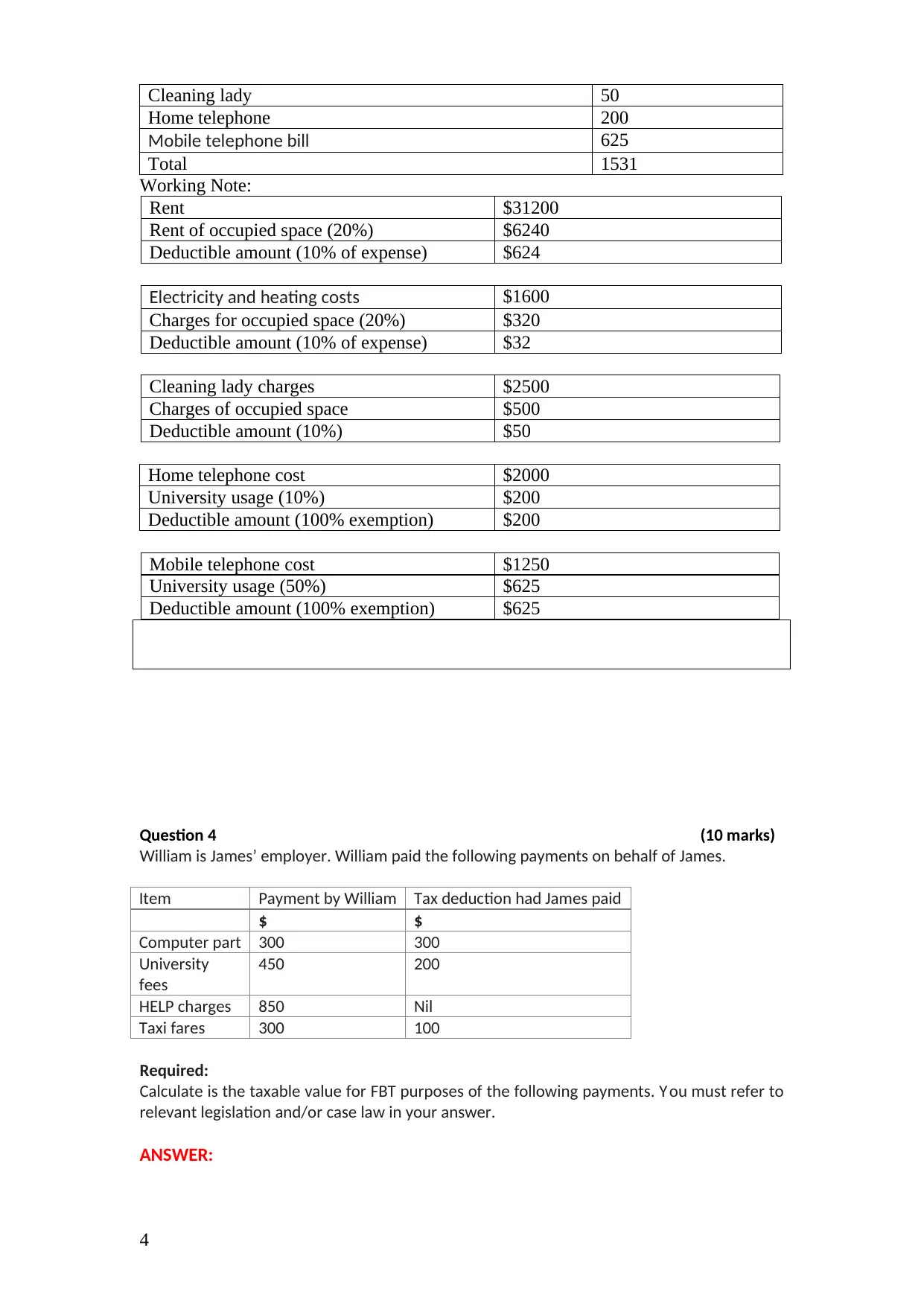
Cleaning lady 50
Home telephone 200
Mobile telephone bill 625
Total 1531
Working Note:
Rent $31200
Rent of occupied space (20%) $6240
Deductible amount (10% of expense) $624
Electricity and heating costs $1600
Charges for occupied space (20%) $320
Deductible amount (10% of expense) $32
Cleaning lady charges $2500
Charges of occupied space $500
Deductible amount (10%) $50
Home telephone cost $2000
University usage (10%) $200
Deductible amount (100% exemption) $200
Mobile telephone cost $1250
University usage (50%) $625
Deductible amount (100% exemption) $625
Question 4 (10 marks)
William is James’ employer. William paid the following payments on behalf of James.
Item Payment by William Tax deduction had James paid
$ $
Computer part 300 300
University
fees
450 200
HELP charges 850 Nil
Taxi fares 300 100
Required:
Calculate is the taxable value for FBT purposes of the following payments. Y ou must refer to
relevant legislation and/or case law in your answer.
ANSWER:
4
Home telephone 200
Mobile telephone bill 625
Total 1531
Working Note:
Rent $31200
Rent of occupied space (20%) $6240
Deductible amount (10% of expense) $624
Electricity and heating costs $1600
Charges for occupied space (20%) $320
Deductible amount (10% of expense) $32
Cleaning lady charges $2500
Charges of occupied space $500
Deductible amount (10%) $50
Home telephone cost $2000
University usage (10%) $200
Deductible amount (100% exemption) $200
Mobile telephone cost $1250
University usage (50%) $625
Deductible amount (100% exemption) $625
Question 4 (10 marks)
William is James’ employer. William paid the following payments on behalf of James.
Item Payment by William Tax deduction had James paid
$ $
Computer part 300 300
University
fees
450 200
HELP charges 850 Nil
Taxi fares 300 100
Required:
Calculate is the taxable value for FBT purposes of the following payments. Y ou must refer to
relevant legislation and/or case law in your answer.
ANSWER:
4
Paraphrase This Document
Need a fresh take? Get an instant paraphrase of this document with our AI Paraphraser
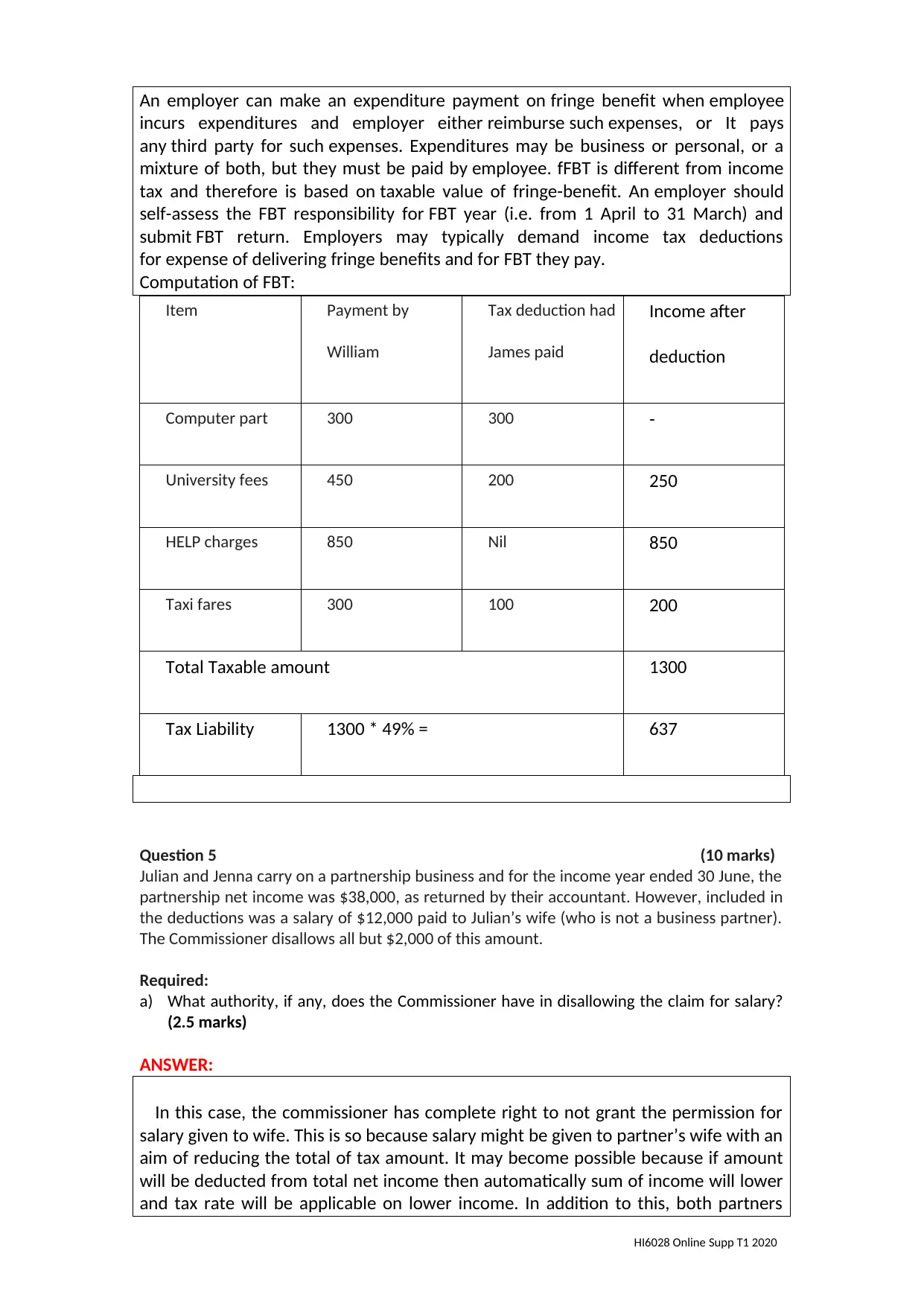
An employer can make an expenditure payment on fringe benefit when employee
incurs expenditures and employer either reimburse such expenses, or It pays
any third party for such expenses. Expenditures may be business or personal, or a
mixture of both, but they must be paid by employee. fFBT is different from income
tax and therefore is based on taxable value of fringe-benefit. An employer should
self-assess the FBT responsibility for FBT year (i.e. from 1 April to 31 March) and
submit FBT return. Employers may typically demand income tax deductions
for expense of delivering fringe benefits and for FBT they pay.
Computation of FBT:
Item Payment by
William
Tax deduction had
James paid
Income after
deduction
Computer part 300 300 -
University fees 450 200 250
HELP charges 850 Nil 850
Taxi fares 300 100 200
Total Taxable amount 1300
Tax Liability 1300 * 49% = 637
Question 5 (10 marks)
Julian and Jenna carry on a partnership business and for the income year ended 30 June, the
partnership net income was $38,000, as returned by their accountant. However, included in
the deductions was a salary of $12,000 paid to Julian’s wife (who is not a business partner).
The Commissioner disallows all but $2,000 of this amount.
Required:
a) What authority, if any, does the Commissioner have in disallowing the claim for salary?
(2.5 marks)
ANSWER:
In this case, the commissioner has complete right to not grant the permission for
salary given to wife. This is so because salary might be given to partner’s wife with an
aim of reducing the total of tax amount. It may become possible because if amount
will be deducted from total net income then automatically sum of income will lower
and tax rate will be applicable on lower income. In addition to this, both partners
HI6028 Online Supp T1 2020
incurs expenditures and employer either reimburse such expenses, or It pays
any third party for such expenses. Expenditures may be business or personal, or a
mixture of both, but they must be paid by employee. fFBT is different from income
tax and therefore is based on taxable value of fringe-benefit. An employer should
self-assess the FBT responsibility for FBT year (i.e. from 1 April to 31 March) and
submit FBT return. Employers may typically demand income tax deductions
for expense of delivering fringe benefits and for FBT they pay.
Computation of FBT:
Item Payment by
William
Tax deduction had
James paid
Income after
deduction
Computer part 300 300 -
University fees 450 200 250
HELP charges 850 Nil 850
Taxi fares 300 100 200
Total Taxable amount 1300
Tax Liability 1300 * 49% = 637
Question 5 (10 marks)
Julian and Jenna carry on a partnership business and for the income year ended 30 June, the
partnership net income was $38,000, as returned by their accountant. However, included in
the deductions was a salary of $12,000 paid to Julian’s wife (who is not a business partner).
The Commissioner disallows all but $2,000 of this amount.
Required:
a) What authority, if any, does the Commissioner have in disallowing the claim for salary?
(2.5 marks)
ANSWER:
In this case, the commissioner has complete right to not grant the permission for
salary given to wife. This is so because salary might be given to partner’s wife with an
aim of reducing the total of tax amount. It may become possible because if amount
will be deducted from total net income then automatically sum of income will lower
and tax rate will be applicable on lower income. In addition to this, both partners
HI6028 Online Supp T1 2020
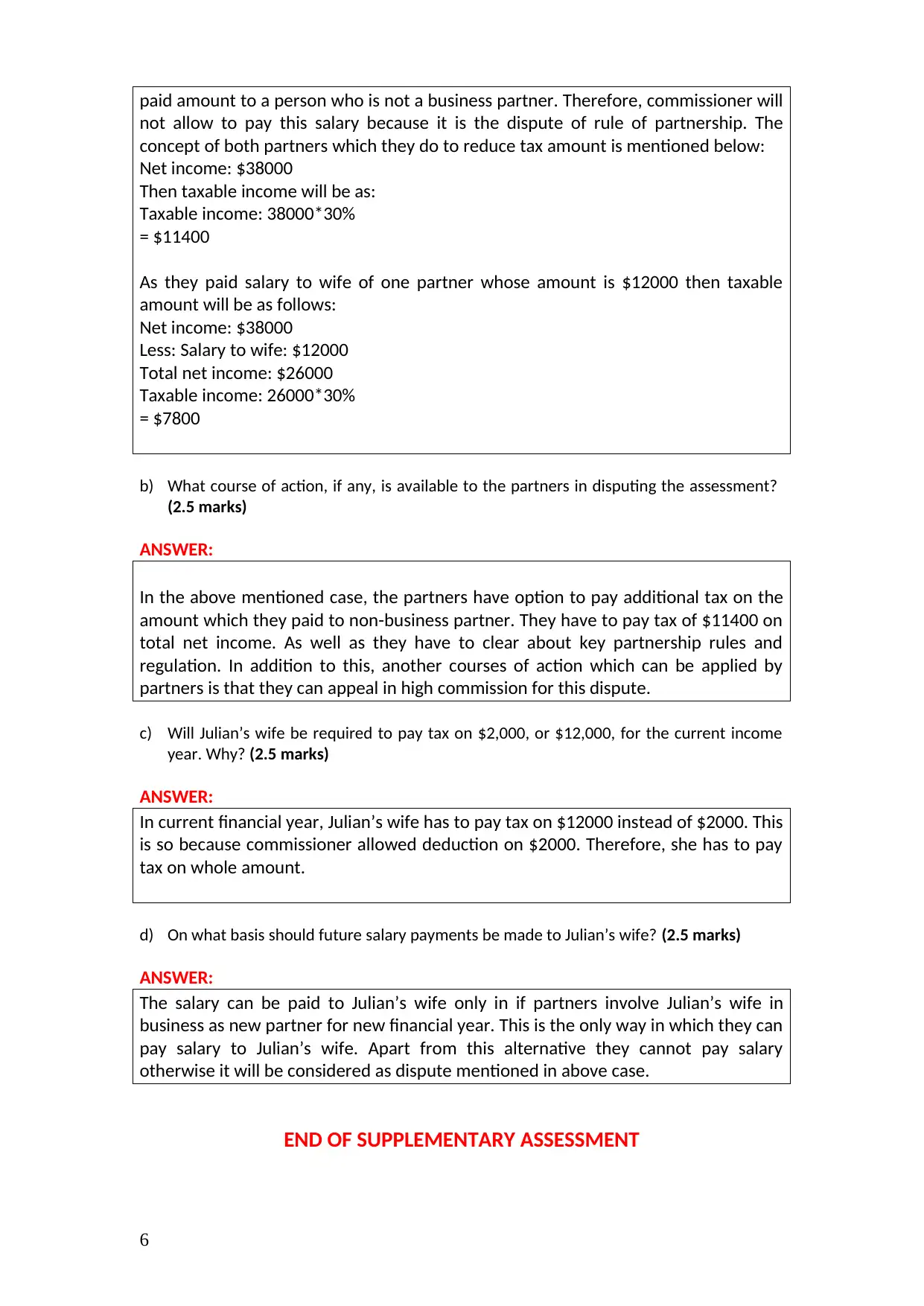
paid amount to a person who is not a business partner. Therefore, commissioner will
not allow to pay this salary because it is the dispute of rule of partnership. The
concept of both partners which they do to reduce tax amount is mentioned below:
Net income: $38000
Then taxable income will be as:
Taxable income: 38000*30%
= $11400
As they paid salary to wife of one partner whose amount is $12000 then taxable
amount will be as follows:
Net income: $38000
Less: Salary to wife: $12000
Total net income: $26000
Taxable income: 26000*30%
= $7800
b) What course of action, if any, is available to the partners in disputing the assessment?
(2.5 marks)
ANSWER:
In the above mentioned case, the partners have option to pay additional tax on the
amount which they paid to non-business partner. They have to pay tax of $11400 on
total net income. As well as they have to clear about key partnership rules and
regulation. In addition to this, another courses of action which can be applied by
partners is that they can appeal in high commission for this dispute.
c) Will Julian’s wife be required to pay tax on $2,000, or $12,000, for the current income
year. Why? (2.5 marks)
ANSWER:
In current financial year, Julian’s wife has to pay tax on $12000 instead of $2000. This
is so because commissioner allowed deduction on $2000. Therefore, she has to pay
tax on whole amount.
d) On what basis should future salary payments be made to Julian’s wife? (2.5 marks)
ANSWER:
The salary can be paid to Julian’s wife only in if partners involve Julian’s wife in
business as new partner for new financial year. This is the only way in which they can
pay salary to Julian’s wife. Apart from this alternative they cannot pay salary
otherwise it will be considered as dispute mentioned in above case.
END OF SUPPLEMENTARY ASSESSMENT
6
not allow to pay this salary because it is the dispute of rule of partnership. The
concept of both partners which they do to reduce tax amount is mentioned below:
Net income: $38000
Then taxable income will be as:
Taxable income: 38000*30%
= $11400
As they paid salary to wife of one partner whose amount is $12000 then taxable
amount will be as follows:
Net income: $38000
Less: Salary to wife: $12000
Total net income: $26000
Taxable income: 26000*30%
= $7800
b) What course of action, if any, is available to the partners in disputing the assessment?
(2.5 marks)
ANSWER:
In the above mentioned case, the partners have option to pay additional tax on the
amount which they paid to non-business partner. They have to pay tax of $11400 on
total net income. As well as they have to clear about key partnership rules and
regulation. In addition to this, another courses of action which can be applied by
partners is that they can appeal in high commission for this dispute.
c) Will Julian’s wife be required to pay tax on $2,000, or $12,000, for the current income
year. Why? (2.5 marks)
ANSWER:
In current financial year, Julian’s wife has to pay tax on $12000 instead of $2000. This
is so because commissioner allowed deduction on $2000. Therefore, she has to pay
tax on whole amount.
d) On what basis should future salary payments be made to Julian’s wife? (2.5 marks)
ANSWER:
The salary can be paid to Julian’s wife only in if partners involve Julian’s wife in
business as new partner for new financial year. This is the only way in which they can
pay salary to Julian’s wife. Apart from this alternative they cannot pay salary
otherwise it will be considered as dispute mentioned in above case.
END OF SUPPLEMENTARY ASSESSMENT
6
⊘ This is a preview!⊘
Do you want full access?
Subscribe today to unlock all pages.

Trusted by 1+ million students worldwide
1 out of 6
Your All-in-One AI-Powered Toolkit for Academic Success.
+13062052269
info@desklib.com
Available 24*7 on WhatsApp / Email
![[object Object]](/_next/static/media/star-bottom.7253800d.svg)
Unlock your academic potential
Copyright © 2020–2025 A2Z Services. All Rights Reserved. Developed and managed by ZUCOL.